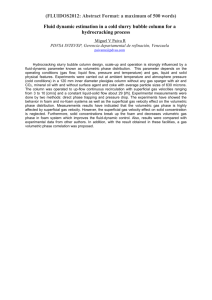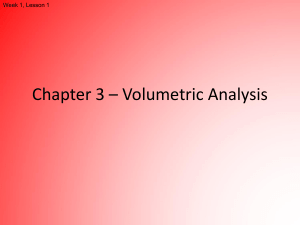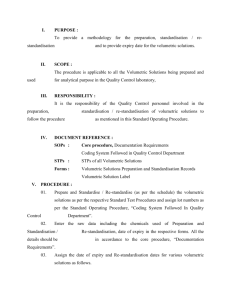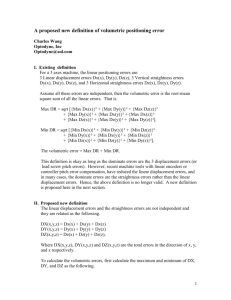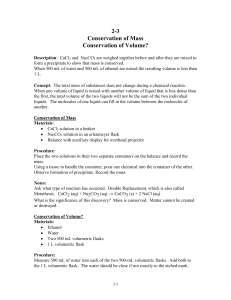Basics of Flow measurements using Hotfilm
advertisement
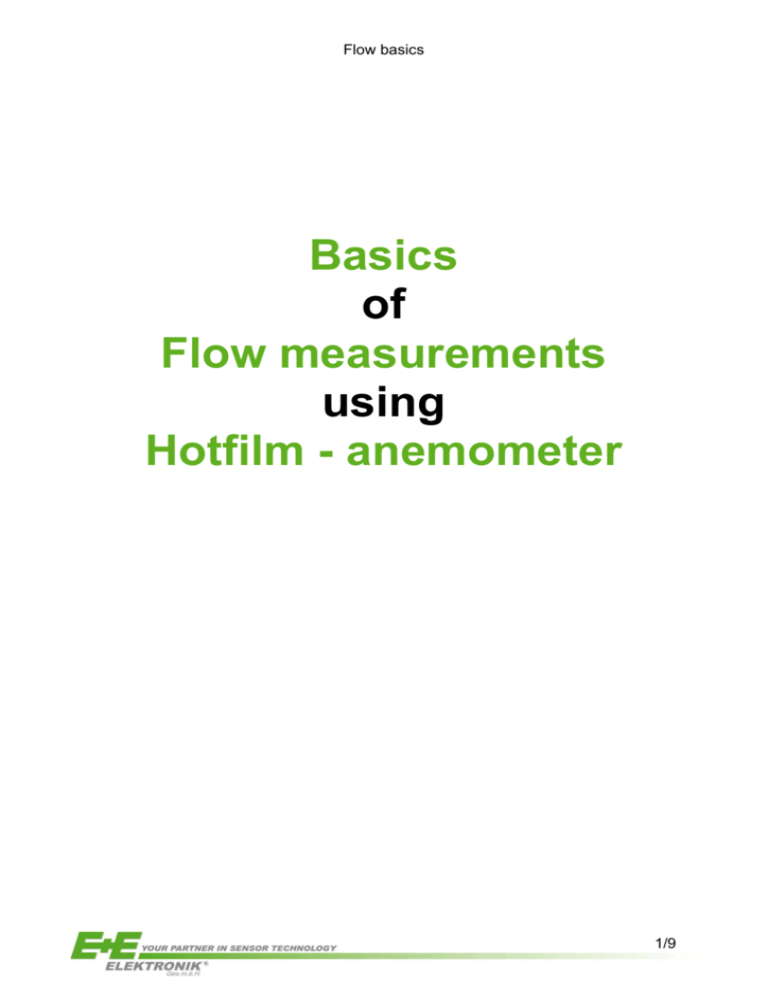
Flow basics Basics of Flow measurements using Hotfilm - anemometer 1/9 Flow basics Inhaltsverzeichnis: 1. Definitions 1.1. 1.2. 1.3. Air Velocity Amount (of Gas) Flow 1.3.1. Mass flow rate 1.3.2. Volumetric flow rate 1.3.3. Standard volumetric flow rate 2. Flow formulas 3. Flow measurements using E+E Hotfilm anemometer 2/9 Flow basics 1. Definitions: 1.1. Air Velocity: Definition: „Air Velocity describes the distance an air molecule is moving during a certain time period “ Units: Name of unit Meter per second Kilometer per hour Centimeter per minute Centimeter per second Meter per minute Millimeter per minute Millimeter per second Foot per hour Foot per minute Foot per second Furlong per fortnight Inch per second Knot Kyne Mile per year Mile (stat) per hour Mile (stat) per hour shift m/s km/h cm/min cm/s m/min mm/min mm/s ft/h, fph ft/min, fpm ft/s, fps furlong/fortnight in/s, ips kn, knot cm/s mpy mph, mi/h mi/min Converted to SI - Unit m/s 1 m/s 0,277778 m/s 1,666667 · 10-4m/s 1 · 10-2 m/s 1,66667 · 10-2 m/s 1,666667 · 10-5 m/s 1 · 10-3 m/s 8,466667 · 10-5 m/s 5,08 · 10-3 m/s 0,3048 m/s 1,66309 · 10-4 m/s 2,54000 · 1-2 m/s 0,514444 m/s 1 · 10-2 m/s 8,04327 · 10-13 m/s 0,44704 m/s 26,8224 m/s 3/9 Flow basics 1.2. Amount (of Gas): The amount of Gas „n“ is the number of moles of gas. 1 mol = 6.023 ⋅ 10 23 molecules. For better understanding and its compact mathematical formulation, the properties of gases are described using an idealised model called “ideal gas”. The amount of an ideal gas is defined using the ideal gas law: p ⋅V = n ⋅ R ⋅ T J . mol ⋅ K Volumes V, pressure p und temperature T are state variables. They are defining the state of the gas amount n. using the universal gas constant R = 8.3145 For known composition of the gas, its amount n can be substituted by its mass „m“ p ⋅ V = m ⋅ Ri ⋅ T using Ri als individual gas constant. It is dependent on the composition of the gas: Gas indiv. Gas constant Ri Air 287 O2 259,8 N2 296,8 H2 4124 CO2 188,9 Finally the amount of gas can be detected in two different ways: 1. Weighing of the amount – measuring the mass of the amount. With known weight of one gas molecule, the amount of gas can be calculated. Mass, measured in kg or g … 2. Determination of the state of the gas: measuring of the volume V. With known temperature T and pressure p, the amount can be caluculated using the ideal gas law. Volume, measured in m3, dm3 or cm3 The ratio between those two quantities is defining the density ρ. density ρ = mass m = volume V ⎡ kg kg g ⎤ ⎢⎣ dm3 , m3 , cm3 ⎥⎦ The density is a parameter of the state of the medium and is defined by the individual gas constant Ri , temperature and pressure of the medium. ρ= p Ri ⋅ T 4/9 Flow basics The density ρ of the gas is linearly dependent on its pressure p und its temperature T. Demonstrative, that can be shown using a cylinder whose volume can be variated by a moving piston p1 T1 ρ1 V1 m p2>p1 T2=T1 ρ2> ρ1 V2<V1 m p3=p1 T3>T1 ρ3< ρ1 V3>V1 m The system is absolutely leak proof, amount and mass of the filled medium is constant. To increase the pressure inside the cylinder the piston is pressed downwards (p2>p1), the gas is compressed, the density of the gas is increasing, the volume is decreasing. On the other hand, by heating the gas inside the cylinder (T3>T1), the density of the gas is decreasing and the volume is increasing! Summary: The mass of a gas with known composition is a direct measure for its amount. The volume is just defining the amount of a gas in combination with its temperature and pressure, but is independent from its composition! To get a „temperature- and pressure independent volumetric-quantity “, the measured volume is recalculated to the volume which would be measured at standardized conditions. This standardized volume VStandard is a volumetric quantity independent from composition, pressure and temperature of the gas. Standard conditions: standard temperature = 0°C = 273 K standard pressure = 1,013 bar Standard volume: Vs tan dard = absolut pressure [bar ] ⋅ 273 K (273 + temperatur e [°C ])⋅1,013 bar 5/9 Flow basics 1.3. Flow A v Flow defines the number of Gas-molecules streaming through the surface A during a certain time- period. The quantities for flow are based on the different quantities for an amount of gas: mass, volume and standard volume 1.3.1. Mass flow rate The Mass flow rate is defining the amount of a fluid with known composition flowing through a surface A in a certain time-periode. m& = Name of unit Kilogramm per second Kilogramm per minute Kilogramm per hour Gramm per second Gramm per minute Gramm per hour Pound per second Pound per minute Pound per hour Mass m [ kg , g ] = time t [ h, s, min] shift kg/s kg/min kg/h GRPS (g/s) GRPM (g/min) GRPH (g/h) LBPS LBPM LBPH Converted to SI - Unit kg/s 1 kg/s 0,01666667 =1/60 kg/s 2,7778*10-4 = 1/3600 kg/s 10-3 kg/s 1,666667*10-5 kg/s 2,7778*10-7 kg/s 0,453592370 kg/s 7,55987*10-3 kg/s 1,26*10-4 kg/s 1.3.2. Volumetric flow rate The volumetric flow rate is defining the volume of a fluid for the present state, represented by temperature and pressure, streaming through the surface A in a certain time-periode. 6/9 Flow basics volume m 3 [m 3 , l ] & V = = time t [ h, s, min] Name of unit Cubicmeter per second Cubicmeter per minute Cubicmeter per hour Cubicdezimeter per second Cubiccentimeter per second Cubiccentimeter per minute Litre per second Litre per minute Litre per hour Millilitre per second Millilitre per minute Cubicfeet per second Cubicfeet per minute Gallons per minute (GB) Gallons per minute (US) shift m3/s m3/min m3/h dm3/s CCS (cm3/s) CCM (cm3/min) LPS (l/s) LPM (l/min) LPH (l/h) ml/s ml/min CFH (ft3/s) CFM (ft3/min) GPM GPM Converted to SI - Unit m3/s 1 m3/s 0,01666667 =1/60 m3/s 2,7778*10-4 = 1/3600 m3/s 10-3 m3/s 10-6 m3/s 1,666667*10-8m3/s 10-3 m3/s 1,666667*10-5 m3/s 2,77778*10-7 m3/s 10-6 m3/s 1,666667 *10-8 m3/s 2,83168*10-2 m3/s 4,71947*10-4 m3/s 7,57682*10-5 m3/s 7,34147*10-5 m3/s 1.3.3. Standard volumetric flow rate Standard volumetric flow rate is independent from state and composition. standard volume Vs tan dard [ Nm 3 , Ncm 3 ] & Vs tan dard = = time t [ h, s, min] Name of unit shift Norm-Kubikmeter pro Sekunde (German) Standard Cubicmeter per second Standard Cubiccentimeter per second Standard cubiccentimeter per minute Standard Litre per second Standard Litre per minute Standard Litre per hour Standard Cubicfeet pro second Standard Cubicfeet pro Minute Nm3/s Converted to SI Unit Nm3/s 1 Nm3/s SCMS (Sm3/s) SCCS (Scm3/s) SCCM (Scm3/s) SLPS (Sl/s) SLPM (Sl/min) SLPH (Sl/h) SCFH (ft3/s) SCFM (ft3/min) 1 Nm3/s 10-6 Nm3/s 1,666667*10-8 Nm3/s 10-3 Nm3/s 1,666667*10-5 Nm3/s 3 2,77778*10-7 Nm /s 2,83168*10-2 Nm3/s 4,71947*10-4 Nm3/s 7/9 Flow basics 2. Flow formulas Volume flow is the direct combination of the surface A, the fluid is streaming through with its average velocity. Volumetric flow rate = average velocity · flow surface V& [ m 3 / s ] = v [ m / s ] ⋅ A [ m 2 ] To calculate the standard volume flow it is necessary to measure actual pressure and temperature. Standard volumetric flow rate = volumetric flow rate at standard conditions V&standard [ Nm 3 / s ] = V& [ m 3 / s ] ⋅ p [bar ] ⋅ 273 K (273 + T [°C ])⋅1,013 bar With known density of the fluid (Air) at standard conditions it is possible to calculate the mass flow. Mass flow rate = standard volumetric flow rate ·Air density at 0°C and 1,013 bar m& [ kg / s ] = V&s tan dard [ Nm 3 / s ] ⋅ 1, 275 [ kg / Nm 3 ] 8/9 Flow basics 3. Flow measurements using E+E Hotfilm anemometer: The measurement principle of a hot-film anemometer is to measure the number of molecules which are streaming over the heater sensor, and so conduct heat. With rising air pressure, the density of the gas is increasing and with the same velocity more molecules are streaming over the sensor. So, to measure the air velocity of the molecules at any pressure, this pressure influence has to be corrected. At E+E all Air Velocity Transmitter are calibrated at Standard Pressure of 1,013 bar. For diverging air pressures from 1,013 bar, that influence has to be corrected. Air velocity: v[m / s ] = vTransmitter [m / s ] ⋅ 1,013 bar p [bar ] The temperature also has a small influence on the heat transfer from the sensor. E+E Transmitters have implemented internal temperature compensations to correct that influence. By measuring the average air velocity in a Tube and with known cross section surface A, the volume flow can be calculated. Volumetric flow rate: 1,013 bar V&[m3 / s] = A[m 2 ] ⋅ vTransmitter [m / s] ⋅ p [bar ] In most industrial applications the volumetric flow rate at standard conditions has to be measured. In that applications the E+E Hotfilmsensor and its calibration at standard pressure shows its main advantages. Because of the opposed pressure influence of sensor and conversion of volumetricflow to standard-volumetric flow, the E+E Hotfilm-Sensors measure standard volumetric flow and mass flow independent to pressure. Standard volumetric flow rate: V&standard [ Nm 3 / s ] = A[ m 2 ] ⋅ vTransmitte r [ m / s ] ⋅ 273 K (273 + T [ °C ] ) Mass flow rate: m& [ kg / s ] = A[ m 2 ] ⋅ vTransmitte r [ m / s ] ⋅ 273 K ⋅ 1, 275 [ kg / Nm 3 ] (273 + T [°C ]) 9/9
